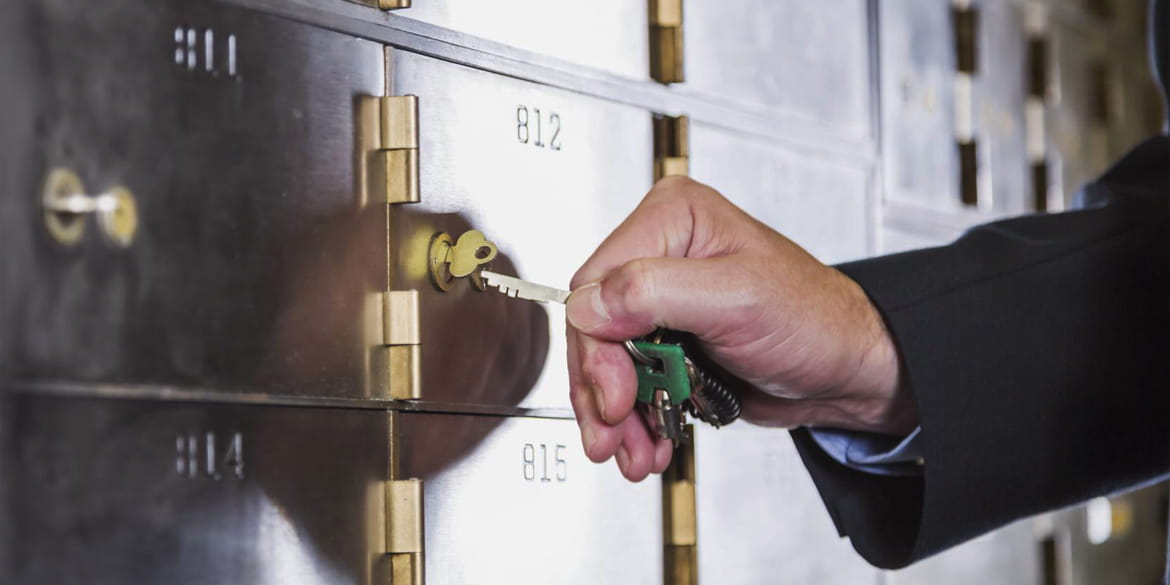Safe deposit locks are a special type of security lock mainly used on safe deposit boxes. These two-key locks require the box renter and bank staff to be present at the same time to open the lock with each of their own keys. The dual access control ensures the highest possible level of security protection of the valuables and assets stored in the box.
This guide covers all major aspects of safe deposit locks, from what they are, how they work, the common types and the active aftermarket for replacement locks. Whether you are building a new safe deposit locker project for commercial or private safe deposit box suppliers or offering maintenance services for banks, this guide includes all the essential information you might need.
In this article, you will learn:
- What Is a Safe Deposit Lock
- How Does a Safe Deposit Lock Work
- Mechanical Safe Deposit Lock
- Combination Safe Deposit Lock
- Electronic Safe Deposit Lock
- Safe Deposit Lock Key
- Change Locks Between Renters
- Service, Maintenance and Aftermarket
- Brands
- Replacement Locks
- Certification
- Conclusion
What Is a Safe Deposit Lock
A safe deposit lock is a dual controlled two-key lock that requires two separate keys to unlock at the same time. These locks usually have two individual locks in one lock case, requiring both a guard key from the bank employee and a renter key from the box’s renter to open the lock simultaneously. As these locks are mostly used on bank safe deposit boxes, they are commonly referred to as a safe deposit lock, safe deposit box lock, safety deposit lock, SD lock or SDB lock.
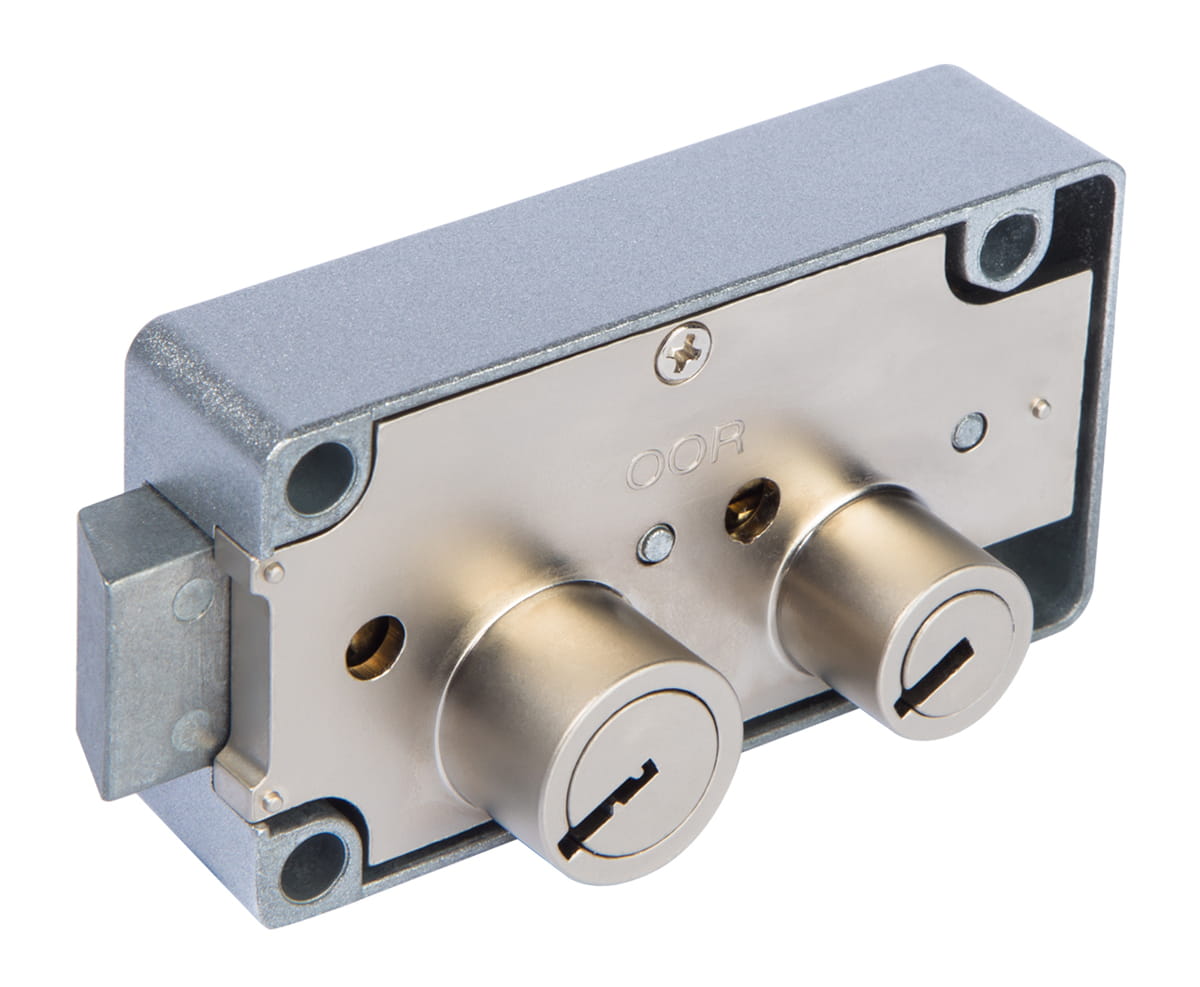
The idea is to ensure the safe deposit box is protected under dual access control, hence the deposit lock requires two keys from different holders. When accessing the box, you need to sign in with the bank with your ID to identify you are the original owner, and then the vault custodian will escort you to your box and unlock the guard side of the lock with a guard key. With the valid guard key inserted and turned open, the renter can now unlock the entire lock with their renter key to retract the lock bolt and open the door.
A safe deposit lock does not have to be extraordinarily complicated or have large volume key variations. It’s the dual control access requirement that makes safe deposit locks highly secure and dependable.
With the fast development of technology and the increasing market demand, safe deposit locks have also upgraded from the traditional two-key locks to other innovative forms. In the modern banking industry, the electronic locking system is increasingly favored by its ease of use and management, versatile features, and high-security performance. Many lock manufacturers have come up with electronic safe deposit lock solutions to serve the rapidly growing needs of auto-service safe deposit locking systems, especially for private safe deposit box suppliers.
While electronic locks are becoming more and more popular, traditional dual key locks are still being largely installed and serviced among all the big banks, credit unions, and commercial safe deposit box suppliers around the world. In this guide, we’ll mainly talk about the traditional two-key safe deposit locks as they are still the primary type of lock being used.
How Does a Safe Deposit Lock Work
A safe deposit lock has two keys controlling the lock from unlocking together. Simply imagine there are two individual locks inside one lock housing that only when two locks are both unlocked the lock bolt is able to retract.
There are two plugs on the lock surface, and each plug is called a nose. The nose located near the lock bolt is called the renter nose, and the nose located near the bottom of the lock is called the guard nose. The key to unlock the guard nose side is called the “Guard Key” which is kept and maintained by bank employees or vault custodian guards. The key to unlock the renter nose side is called the “Renter Key” which is held by the box renters. Usually, both keys are retained when the lock is unlocked and can only be withdrawn after the lock is closed again for security purposes.
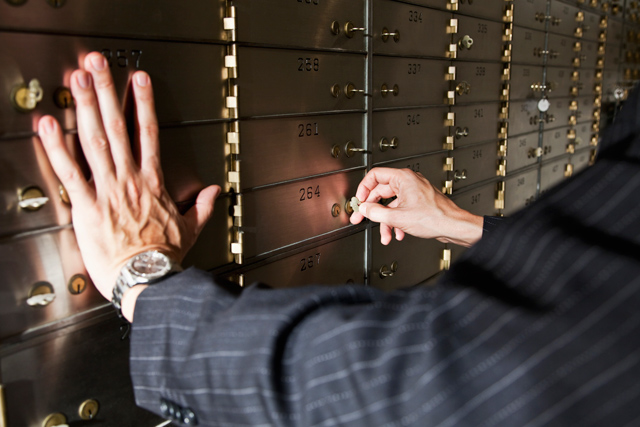
Each nose can be considered as an individual lock with lever tumblers that blocks the “fence” of the lock bolt from retracting. With the valid key, the lever tumblers can be correctly aligned, allowing the fence to move.
Usually, only the renter part of the locking mechanism can move the lock bolt with a connecting component called “foot”, while the guard lock only blocks the fence from moving. So the guard key should be inserted and turned first, then users are able to use the renter key to retract the lock bolt.
For other types of safe deposit lock systems, such as auto service electronic lock systems, fingerprint access locks, and combination locks, the opening method is nearly the same. Banks or private safe deposit locker suppliers identify your ownership of the box and grant you access to your box. Now renters can open their box with either a key, combination, or fingerprint.
Mechanical Safe Deposit Lock
The mechanical safe deposit lock is the most traditional and classic type of lock which we will mainly discuss in the article. The most common mechanical safe deposit locks are the double-nose, lever tumbler locks with flat keys and they have been widely used in the US and the rest of the world.
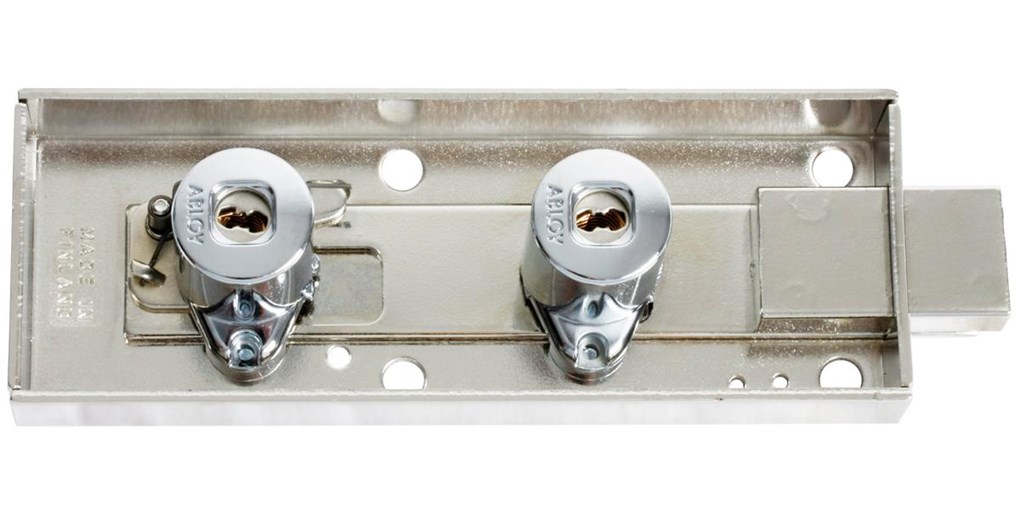
There are also cylinder lock or double-bitted lever lock types of safe deposit locks popular in the European market. These types of locks usually do not have noses and are not interchangeable with the standard double-nose safe deposit locks.
Fixed Safe Deposit Lock
A fixed safe deposit lock is non-changeable with the lever tumblers in the lock case fixed and cannot be released. The fixed safe deposit lock is just like a regular lock with only one matching key pattern and cannot accept new keys.
To change the keys of a fixed-lever lock, also known as rekeying, a locksmith is required to disassemble the lock and change the levers to match a new key, which is typically the same as assembling a new lock.
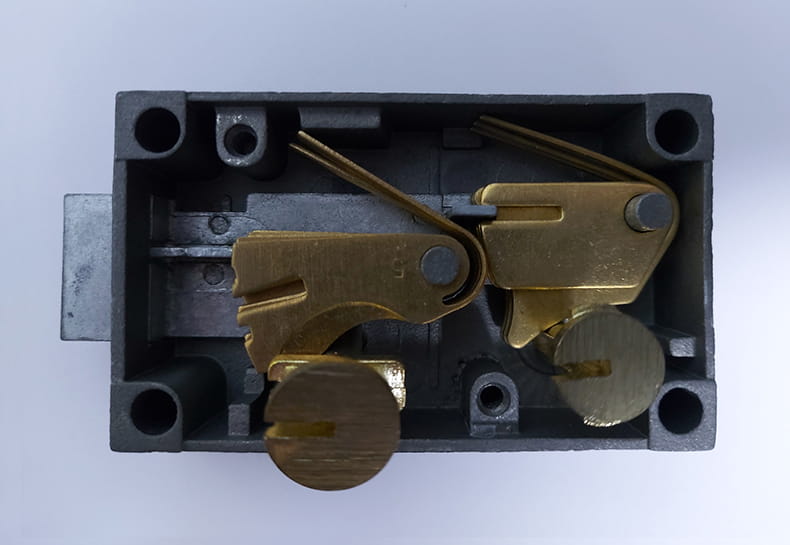
The advantage of the fixed-lever mechanism is that these locks are very dependable and could rarely fail. Fixed safe deposit locks can work without a problem for years compared to changeable locks.
Changeable Safe Deposit Lock
A changeable safe deposit lock can be changed to accept a new key without the need to disassemble the lock. A change tool is being used to allow the lock to set to a new key after being unlocked with the valid old keys. Changeable safe deposit locks are available in double-changeable or one-fixed, one-changeable types to serve customers’ diverse needs.
Generally, there are two types of changeable lock design: changeable levers and changeable fences. The concept of how to reset the lock is mostly the same. In plain words, we use the old keys to open the lock first and remain at the opening position. Then we use the change tool to loose the mechanism, allowing it to move freely to adapt to any new key pattern. Because the lock remains at the unlocked status, the new key inserted should also be able to open the lock. Then we tighten the mechanism, and the new key has been successfully set.
Changeable lever design is mostly seen on early locks, such as the LeFebure 7700 series. The changeable levers are controlled by a toothed shaft in the center of the lock. To reset the lock, we need to open the lock first with the valid old keys and use the change tool to turn the shaft to release the levers. Then we turn the new key to the open position again, making the levers adapt to the new key pattern and lock the shaft.
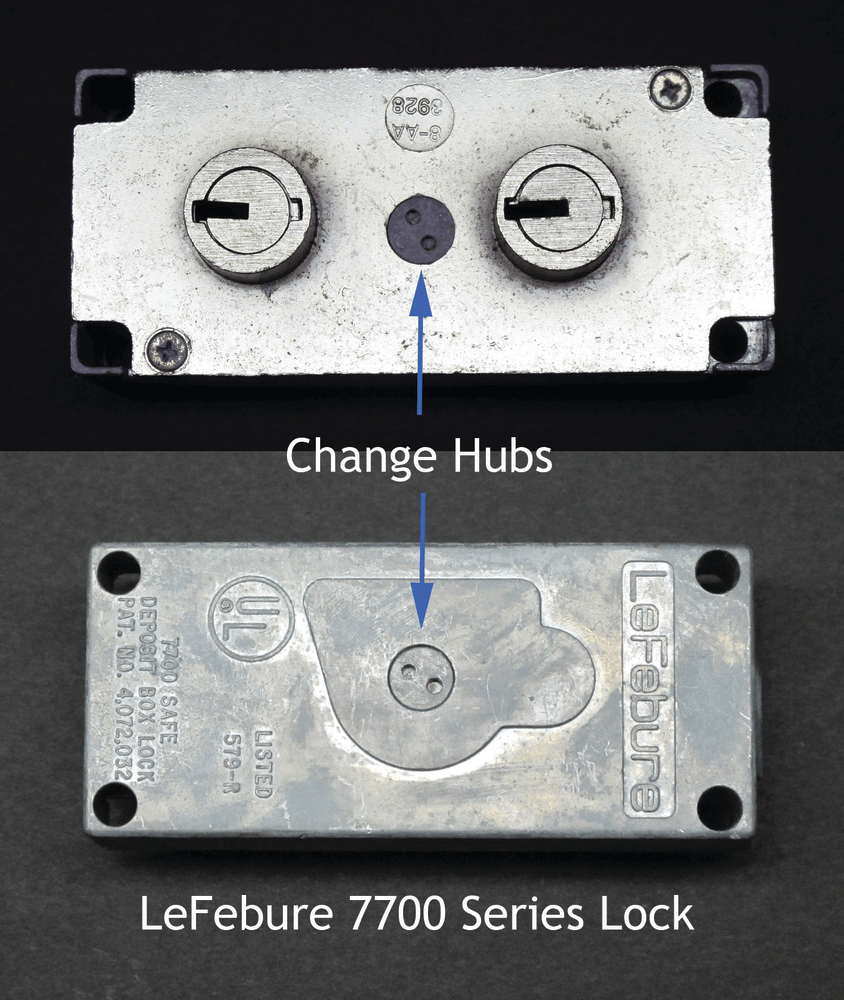
The drawback of changeable lever design is that the levers might not always be accurately well-aligned and locked in the right position after changing. When the shaft is fixed with the levers not well-aligned, the levers might slip after several times of successful openings and finally lock in. Then you have to call a locksmith to drill out that lock to get the box open.
To change the key on a changeable lever lock:
- Unlock the lock with both correct renter and guard keys
- Use the change tool to unlock the shaft
- Remove the current key that needs to be changed
- Insert the new key and turn it to the opening position
- Use the change tool to lock the shaft
- The new key is set and test a few times with the door open
Changeable fence design is still widely used to this day and can be often seen used on high-security changeable key locks too. Unlike a fixed lock where each lever is different for creating key variations, the changeable fence design lock has identical levers where the key variations are determined by the different contacting positions of the fences and levers. The fences are tightened by a change screw, usually an inner hex screw. With a change tool to loosen the screw, the fences become resettable and the contact position is allowed to be changed to adapt to a new key.
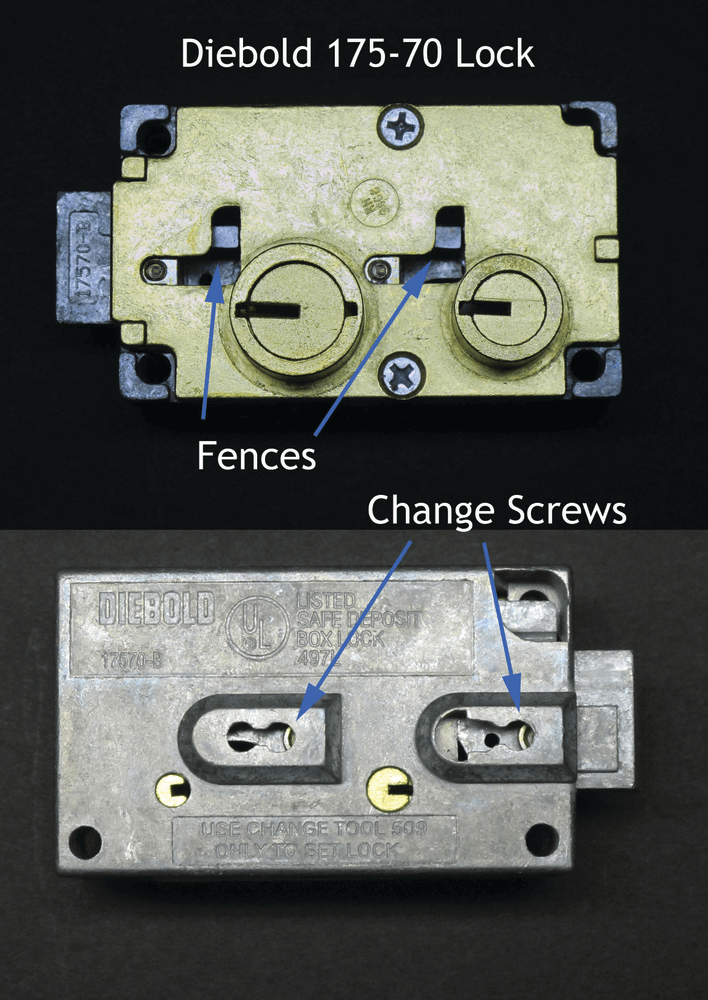
To reset the lock, first we need to open the lock using the valid old keys and use the change tool to loosen the changeable fences so the fences are free to move up and down to adapt to a new key pattern. Then we insert the new key, turn it to the open position and tighten the fence again.
The advantage of the changeable fence mechanism is that it’s more stable and reliable than changeable lever locks and the levers are free from misalignment problems. What’s more, the changeable fences for renter or guard key are completely independent so users can choose to have either key changeable or fixed where a changeable lever lock is usually only double-changeable available due to the symmetrical design. For example, some banks prefer to only have the renter key changeable but the guard key fixed because it can reduce the possibility of accidentally changing the guard key.
To change the key on a changeable fence lock:
- Unlock the lock with both correct renter and guard keys
- Use the change tool to loosen the change screw(3 ½ counterclockwise)
- Remove the current key that needs to be changed
- Insert the new key and turn it to the opening position
- Use the change tool to tighten the change screw
- The new key is set and test a few times with the door open
After a box is surrendered, the returned renter keys should be changed before the box can be rented to a new lessee again because anyone can open the same box with a key copy if the lock is not changed or rekeyed. With a changeable safe deposit lock, the rekeying process is very easy and can be done by the bank staff without the need to call a locksmith.
Left Hand, Right Hand and Non Hand
Safe deposit locks are available in handed locks and non handed locks:
- Left Hand (LH) locks are installed on a left hand door where the door hinged is at the left side
- Right Hand (RH) locks are installed on a right hand door where the hinged is at the right side
- Non-handed locks can be installed on either left hand or right hand door by flipping the lock over because the nose is at the central line
How to identify the hand type of a safe deposit lock?
Face the noses of the lock and the nose will be located below the centerline when it’s a handed lock:
- If the lock bolt points to the left, it’s a right-handed lock
- If the lock bolt points to the right, it’s a left-handed lock
- If the nose is at the centerline, it’s a non-handed lock
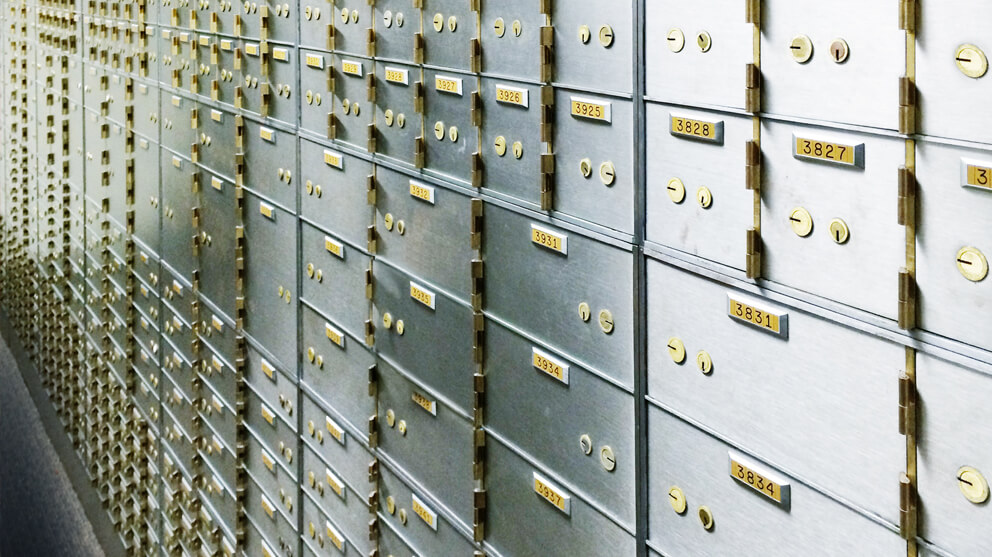
Most of the safe deposit locks that we use are right hand(RH) locks. The left hand(LH) locks are generally used on the last row of boxes near the wall where the right hand door cannot fully open.
Nose Type
A safe deposit lock can have a diverse nose design with a combination of different nose sizes, nose heights and number of noses.
Big Nose and Small Nose
Normally, there are two types of nose sizes(diameter of the plug): the big nose: 0.672” (17.1mm) and the small nose: 0.840” (21.3mm).
Nose Height
Normally, there are two types of nose heights: ½” (12.7mm) and ⅜” ( 9.5mm).
Double Nose and Single Nose
Normally, a safe deposit lock can have either two noses or only one nose, which is called a double nose or single nose lock.
The double nose safe deposit lock is the standard lock. A double nose safe deposit lock can be double changeable, double fixed, or one changeable one fixed lock according to the actual needs.
A single nose safe deposit lock can be either a double nose lock by simply removing the guard nose so users can use only their renter key to unlock OR a single nose lock that still requires a guard key and renter key to unlock the same as a regular safe deposit lock.
Combination Safe Deposit Lock
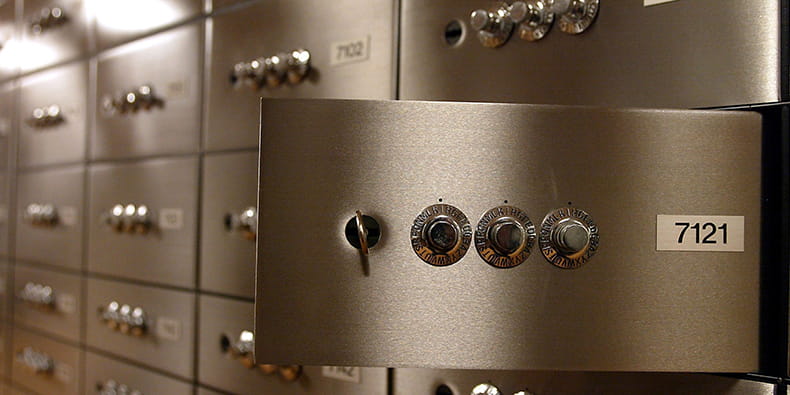
Combination safe deposit locks utilize combination locking systems instead of regular key locks. Usually, there are three combination dials on the lock surface that allow users to input their renter code.
Electronic Safe Deposit Lock
Electronic safe deposit locks are getting popular with the growing trend of automated self-service safe deposit lockers provided by private commercial suppliers so that customers can visit their box anytime they want with their renter keys. Many banks integrate electronic safe lock systems for the purpose of audit and management such as installing electronic safe deposit locks with ordinary key lock for renters but with the guard side controlled by an electronic locking system without the necessity of a physical guard key.
There are many forms of electronic deposit locks or locking systems that we will not be fully into discussing here because lock manufacturers usually have their own designs for the electronic part. These locks are more like a locking system rather than a standalone lock that we are not able to thoroughly cover in this article.
Safe Deposit Lock Key
Most safe deposit lock keys are flat keys with small key bows. Here is some useful information regarding the safe deposit keys.
Renter Key
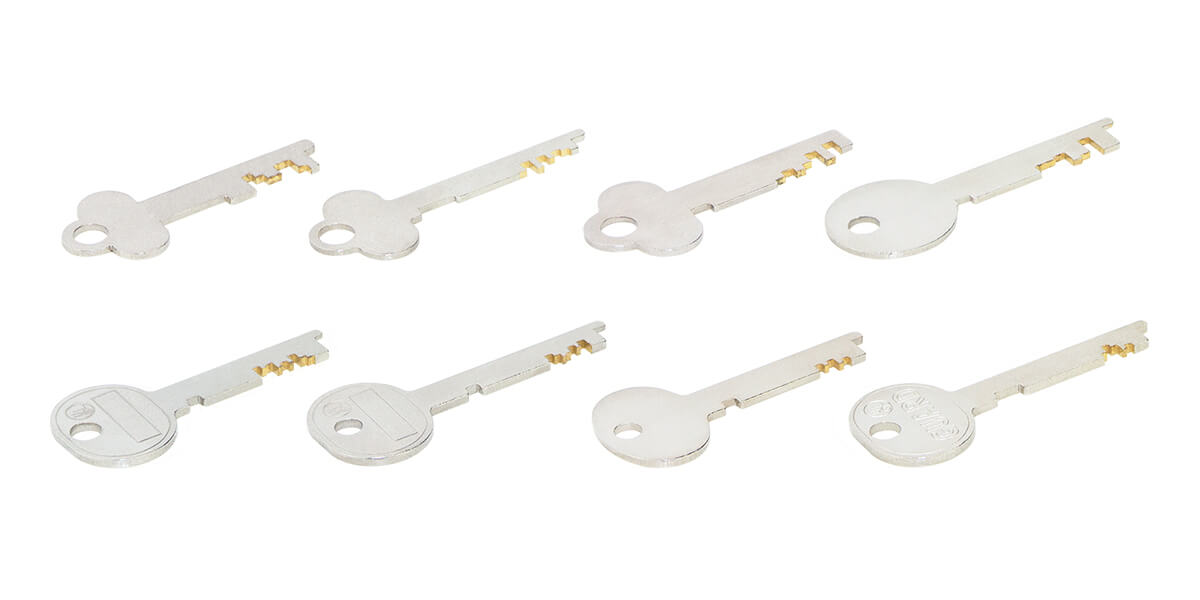
The renter key is the key held by the renter of the box. Usually, there are two renter keys to a lock in case one of the renter keys is lost.
Guard Key
The guard key is the key held by the bank employee. Usually, for all the locks located in one bank vault, the guard keys are the same for every lock. So only a few guard keys are needed for opening all the boxes and not every lock is provided with a guard key when shipping from the manufacturer.
Key Blank
A key blank is a blank key that has not been cut to a specific bitting. A key blank can be used to cut new keys or duplicate existing keys. Key blanks are often stamped ‘Do not duplicate’ and securely stocked by banks, often stored in a safe deposit box especially used for keeping guard keys and key blanks. Key duplication is fine as long as it’s under the bank’s control and the lock is also changed afterward so that the duplicated key cannot open the former box.
Routing Number
Many safe deposit lock keys would have the bank’s routing number printed on the key bows so that customers can identify and recognize the bank of your safe deposit boxes. It’s not mandatory by federal laws but it might be required by states such as Texas.
Key Duplication
Most of the time, safe deposit keys are prohibited from duplication because it can significantly increase the risk of the box being opened by unauthorized people who have a key copy. Normally, there is a “Do Not Duplicate” sign on the keys so that most locksmiths won’t duplicate them.
But there is no law against key duplication so it’s totally legal to duplicate the deposit keys in most states, and many locksmiths and companies do offer key duplication services.
When you lose one of your keys, do not even think about duplicating another key. Your key might get stolen by one of your relatives who knows about your box. The only thing you should do is go to the bank and ask for a lock change or rekeying.
Change Locks Between Renters
There is no federal law or regulation that mandatorily requires the safe deposit locks to be changed between renters, but it’s strongly recommended to do so to guarantee the new box renters are receiving the only two keys that can open the box.
After the old renter gives up the box and the box is surrendered, even when the bank receives both two keys, it’s possible that a key copy has been made in secret. If the former lessee had a copy of the renter key, he could still access the old box if the lock is not changed after leasing to a new renter.
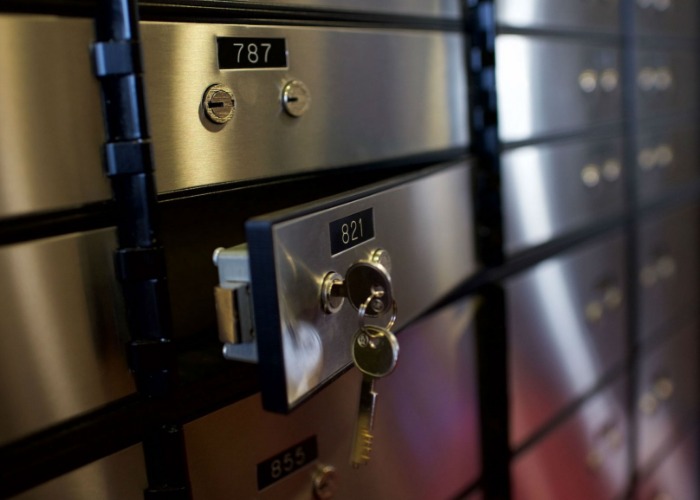
Things happened that customers claimed a large amount of cash and assets were stolen from the box and it turned out that it was the prior customer that opened the current customer’s box with a copy of the renter key after the box was surrendered.
It’s a high risk for the bank to not change locks before leasing the box to a new customer and it can reduce bank liability if a renter claims for items disappearance or lost in his box. So, the locks must be changed after the box is surrendered before they can be rented again.
Usually, there are three ways to change locks between renters:
Replace With a New Lock
Whether it’s a changeable or fixed lock, you can simply replace the old lock with a new lock if you have some stocking of the locks for replacement.
Swap Locks Between Boxes
You can also swap the locks from the surrendered box with one from unrented boxes.
Rekey the Lock
For a changeable safe deposit lock, you can rekey the lock and set a new renter key, as long as it’s done under dual control with at least two bank staff and well documented.
Service, Maintenance and Aftermarket
The service and maintenance of the safe deposit locks are usually done by bank equipment services companies and sometimes by independent locksmiths. Aftermarket safe deposit locks are in great demand in many scenarios.
When a customer loses his key, locks can’t open or fail while changing keys, or the boxes are required for an opening by a court order or upon the death of the owner, service companies and locksmiths are needed to technically open the lock.
When a customer loses one of the two assigned renter keys, most banks do not allow a duplicate key to be made. It’s too much risk for the bank because the lost key might still be able to open the same box if the lock is not changed. Any person with the lost key can open the box, especially when the person is familiar with the renter and knows which box belongs to the key.
In such a case, the bank might ask a locksmith to replace the lock and keys or sometimes rekey the lock in the company of the box holder and two bank employees, which would cost the renter about $150. A quick solution is to close the box, move the items to a new box using the remaining renter key, and sign a new lease contract. In this way, the bank does not need to call the locksmith immediately and can wait till there are multiple locks to be serviced together later.
When a customer loses both the two renter keys, a locksmith is required to technically open the box without keys. The box opening procedure usually falls into three categories:
Lock Picking
Lock picking is the traditional and non-destructive way to technically get the lock open without keys. It can be very fast to open some of the lock models with the right lock pick tools such as the Diebold 175-70 locks. But the lock picking method is not very commonly used for two reasons:
- Lock picking might be time-consuming compared to other methods like nose pulling. Some tricky antique deposit locks do take time to pick.
- Banks want customers to think the lock is high security and hard to pick so they’d rather destroy the lock. Anyway, these locks are inexpensive to replace compared to their reputation for the safe custody of millions of valuables in the vault.
Nose Pulling
The nose pulling method is to open a safe deposit lock by pulling the renter plug with a nose puller. In brief, after removing the renter’s nose by either drilling or using a nose puller, the lever packs inside the renter plug will naturally drop, allowing the lock bolt to move past them.
In most cases, the guard key is well kept by the bank so we need to only pull the renter nose and use the guard key to unlock the entire lock. In rare cases, the guard key can be lost as well, such as in an abandoned bank vault or when the safe deposit lock is installed on the inner compartment of safes as a dual controlled lock. We can do the same on the guard nose, and then we can retract the lock bolt with some additional manual work by retracting the lock bolt from the outside.
Nearly all fixed lever safe deposit locks and some of the changeable locks can be opened by the nose pulling method. They share a similar mechanism design that the levers will drop enough for the lock bolt to retract after the nose has been removed.
Door Pulling
The door pulling method is to pull the door open with a door puller, completely destroying the lock without retracting the lock bolt. In brief, after pulling the renter’s nose, we insert the door puller via the renter plug and forcibly pull the entire door out.
Some locks cannot be unlocked by the nose pulling method, such as some LeFebure lock models, because the levers inside still block the lock bolt from retracting after nose removed. In this case, the door pulling method is the best and only way to get the door open.
Brands
There have been many different companies supplying safe deposit locks over the years. Some brands are still active today such as Sargent & Greenleaf and Diebold(now Diebold Nixdorf) and some are defunct or acquired such as Moser Safe and LeFebure.
Active Brands
- Diebold: Diebold 175-05 series fixed lock, Diebold 175-70 series changeable lock
- Guardian: Guardian 6832 changeable safe deposit lock
- Kumahira: KD-73 series, KD-76 series
- Sargent & Greenleaf: S&G 4440 series fixed lock, S&G 4500 series changeable lock
- BlueGrass: Major brand replacement locks
- Bullseye: Major brand replacement locks
- Carl Wittkopp: European style SD locks
- Kaba Mauer: European style SD locks
- Assa Abloy: European style SD locks
Defunct Companies
- Ilco: Ilco 5400 series, Ilco a400 series
- LeFebure: LeFebure7300 series, LeFebure 7700 series
- Miles-Osbourne: Miles x-4 series
- Mosler: Mosler 5700 series, Mosler 3175 rapid set series
- Precision: Precision 5400 series
- Yale: Yale 3300 series, Yale 3600 series, Yale 4500 series, Yale B200 series
- York: York 145 series, York 245 series
Replacement Locks
Though these defunct companies discontinued producing safe deposit locks, their locks are still widely installed, used and serviced in many big bank vaults such as the well-known Mosler and LeFebure locks. When servicing these discontinued locks, some locks get destroyed when getting drilled out or damaged due to normal wear and tear.
Replacement locks for these discontinued lock models are in great demand for keeping offering ordinary maintenance services for the big banks. For the active brands and lock models, aftermarket deposit locks are also in need for quick and cost-effective lock replacements.
Generally, the safe deposit replacement locks share the same footprint as the original locks so they can be installed directly on the same door plate with identical mounting dimensions. The inner mechanism of the locks and the keys are not necessarily the same as the original.
Certification
In the US, the safe deposit lock is tested and certified under UL 437. The UL 437 is the standard and certification for safety key locks, also covering the two-key lock which is the safe deposit lock. In UL 437, the two-key lock is defined as a two-key, plate tumbler type lock constructed for use on safe deposit boxes, collection safes, and the like to resist unauthorized opening by picking, impressioning, lock bumping, or forcing methods. There is only one grade for safe deposit lock, any lock that passes the UL 437 test is certified as a UL Listed safe deposit lock.
A UL-listed safe deposit lock should resist attacks against picking, lock bumping, impression for at least 45 minutes and forcing for at least 5 minutes. UL 437 does not have a requirement for safe deposit locks against attacks including drilling, sawing, prying, pulling or driving.
UL 437 also has a requirement for key changes: there shall be at least 64 guard key changes and at least 15,000 customer key changes for a design.
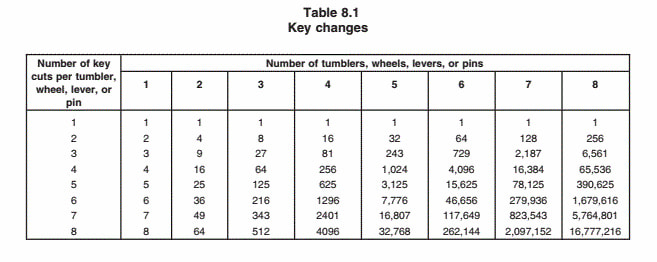
From the key changes chart, we can see that a renter key should have at least 5 levers to meet the UL standard.
Number of Levers
Commonly safe deposit locks contain 5~7 levers, and the more levers it has, the higher key variations it can provide. Nowadays, the renter side usually contains 7 levers, and the guard side may have fewer levers for about 5~7 but usually the same number as the renter side.
Conclusion
The safe deposit industry carries its major weight in the banking and safe storage business to this day. The exclusive off-site safe storage characteristic cannot be taken over by any home safe no matter how secure your safe will be. Burglars and thieves won’t even know you have valuables stored in a safe deposit box behind a thick bank vault. As long as the need for off-site safe custody is there, the safe deposit locks will always be in great demand.
